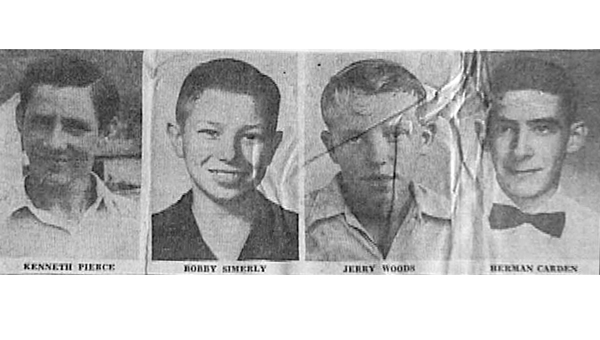Local man suggests memorial for firefighters killed in 1954
Published 8:46 am Monday, March 9, 2020

- A photo from the Elizabethton STAR on Feb. 28, 1954, which shows the photos of the young men killed in the Jenkins mountain fire.
When it comes to news, March has always been unpredictable. A few of the old-timers left remember March 1936, when Carter County receives one of its biggest snows. A brief item in Frank Merritt’s “Later History of Carter County” notes: “The heaviest snow in 50 years fell on March 17, St. Patrick’s Day.” There was two feet of snow in town with 40 inches at Roan Mountain. Erwin had five feet; Newland, N.C., six feet. Snow fell for 31 continuous hours, marooning 100 at Tipton’s Cafe near Roan Mountain. Several city businesses sustained roof damage from the snow.
The day before the snow fell was a warm spring day a kin to some of the warm days we’ve experienced recently.
Other memorable March events included 1938, when two persons were sentenced to death in the Gouge dynamite blast, which killed the three young daughters of Harmon Gouge. White Tollett and Lester Church received the death penalty. They were sentenced to die May 28. Lester Church cheated the electric chair by hanging himself in the Carter County Jail March 17.
Trending
The three young girls, Sonia, nine, Roma Jean, six, and Leuna, seven, were killed when their home was leveled by a dynamite blast while they slept in January 1938.
Then, in March 1939, three persons were killed in a plane wreck near Elizabethton, among them well-known athlete, Ed Laws. The family later established the “Ed (Bulldog) Laws Memorial Trophy” for an outstanding Elizabethton High School athlete.
In March 1941, the new Stateline Road between Hampton and Valley Forge was opened though construction continued. The new road, 2.3 miles in length with two bridges, cost $225,000.
In March 1950, the Happy Valley High School basketball team won the state championship. Jack Edens, center, led the way to victory over Knox High 34-26. Monta Clark was voted the Most Valuable Man in state tournament. Other team members included Paul Cochrane, Ted Maxwell, Paul Whitehead, Pat Ellis, Bill Swatzell, Max Campbell, Ken Meredith and Richard Tittle.
Ten years later, the Hampton Bulldogs won the state championship. Willie Malone, who died a week ago, was named to the All Tourney Team and Carl Roberson to the Second All Tourney Team.
These are just of the few March events that many still remember.
Trending
A couple of weeks ago, Kenneth Howard Nave, a Siam resident, who with his wife now live at Sycamore Springs Assisted Living, called to jog my memory of the Jenkins Mountain fire in late February 1954, in which four young Carter County men were killed. Nave’s nephew, Herman Carden, was among those killed.
Nave suggested a local memorial be built for the four young men who perished in the fire. “It’s been so long ago, but I think a memorial in their honor to remember their bravery and valor would be good,” he said.
The fire in which the young men died occurred Feb. 27, 1954, when a strong wind pushed the fire upslope and the fire crowned.
The firefighters were caught on the slope above the fire and were overun. All four perished.
Thirty hours later on March 1, 1954 a heavy snow fell — one foot to be exact. Had it come earlier, it might have saved the lives of the four firefighters, who died in the Jenkins Mountain fire.
The four who died in the 1954 fire were 15-year-old Robert Simerly and Herman Carden, Kenneth Pierce and Jerry Woods, all 19.
The four had been recruited by young Simerly’s father, Will Simerly, to fight the fire on rugged Jenkins Mountain, which broke out, Saturday, Feb. 27. The fire began when a Hampton man was burning a sage grass field behind his residence and the fire got out of control.
Simerly, a state fire crew leader, narrowly escaped death himself.
Charged with “malicious mischief by setting fire to an open forest” was Dallas Lyons, 33, of Hampton, who is now deceased.
According to an Elizabethton STAR article, the 1954 fire was termed a “crown fire” with the fire sweeping through the treetops. The fire overtook the four young men as they fled from a fire line they were manning in an effort to halt the blaze near the top of the rugged peak on the Hampton side of Jenkins Mountain. The newspaper account of the fire on Feb. 28, 1954, said the four were trapped by a suddenly, shifting wind that swept flames into a narrow hollow high on the mountain overlooking Hampton.
It had been a bad year for forest fires as the Jenkins Mountain fire was the eighth forest fire that crews had battled since Jan. 1. A total of 73 state and federal firefighters were called in to battle the Jenkins Mountain blaze, which burned a total of 300 acres of land. That same afternoon two more forest fires broke out — one on the Valley Forge side of Jenkins Mountain and one on the back side of Lynn Mountain, which burned a barn and about 50 acres of land.
The newspaper report read: “The spectacular but deadly blaze on Jenkins Mountain was brought under control five hours after the state fire crew under Will Simerly lost four of its members in the opening stages.”
Three hours later, Simerly was located after he made his way down the mountain by another route.
A sixth member of the crew, James O. Reece, escaped, but suffered burns on the head, neck and leg. Reece told the newspaper he had been fighting the blaze about 50 feet from the four, when a sudden shift of the wind sent the flames flying through pine trees in a deadly crown fire. Reece said the crew had their back fire going. The four that died were raking.
Gordon Ward, who was a STAR photographer at the time, and reporter Mack Morriss traveled to the scene of the fire by moving up a narrow, tangled gully with the Carter County Rescue Squad, which was assigned to remove the bodies.
Morris wrote: “We went up past Lyons’ house, white two-story building perched on the slope at the end of the woods, and into the skeletal undergrowth and slim little hardwoods that had been blistered by the fire.
“The gully was filled with shale rock, making footing difficult and into it had fallen trees so that the only way forward was through their branches….None of us moved far without resting.”
Morriss reported as they were going up the mountain they heard a sudden roar like a train in a tunnel, which was frightening, terrible. In a moment it quit. Morriss said they were told it was the fire.
All four boys lived in the Siam community. The funerals for Woods and Carden were held the following Monday at the Siam Baptist Church; Pearce’s funeral was also held at Siam Baptist. Simerly’s funeral was held at Rittertown Baptist Church.
Many still remember that tragic Saturday and the days in early March that followed.
Fred Bowers, a retired photographer, told this reporter that he was just a teenager and was at the STAR with Gordon Ward, his mentor. “I asked to see the picture,” Bowers said. “He told me, ‘you don’t want to see them.’ I said, “yes, I do.’”
“I remember there was nothing there but their wallets and belts,” Bowers said.
Some of the young men and women who served as pallbearers and flowerbearers at the four young men’s funerals are still alive today.



